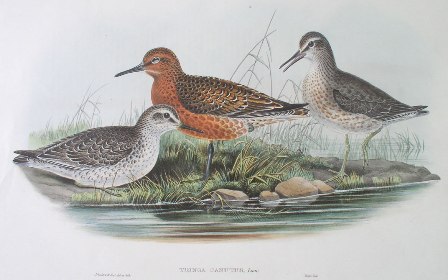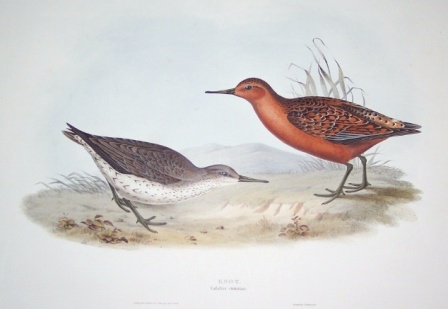
Red knots are the second most numerous Arctic wader to reach New Zealand. Between 45,000 and 70,000 reach New Zealand each summer and about 4,000 – 8,000 over winter.
The New Zealand Wader Study Group has shown from banding recoveries and leg–flag sightings that adult red knots reach New Zealand in September – October from their breeding grounds on the Chukutski Peninsula of eastern Siberia after four to five flights down through eastern Asia and Australia or Irian Jaya. Many juveniles stop in Australia before moving on to New Zealand in their second year.
The return journey from New Zealand starting in March – April is apparently mainly through staging areas in the Gulf of Carpentaria and New Guinea and then on to the coast of China or Korea.
“Red knots in non-breeding plumage are one of the least distinctive waders, which is why lone birds are often mistaken for other invariably much rarer species. Grey above and white below apart from some light barring on the breast and sides, they have some pale barring on the rump and uppertail coverts. The legs range in colour from mustard, as in young birds, to blackish in adults. They are gregarious, roosting and feeding in dense flocks. In breeding plumage, red knots are much more impressive. Their breast and underparts becomes rich red-orange, which in some birds spreads up around the face and head, and their upperpart feathers become grey or blackish with red spots or notches and white tips. The species most easily confused with the red knot is its larger cousin, the great knot which also migrates to New Zealand but in much smaller numbers. Great knots are always longer-billed than red knots, and have a whitish rump that shows up in flight. In non-breeding plumage they have bolder chevrons down their sides, more dark markings on the breast, a less cleanly marked supercilium, heavier streaking on the forehead, and the feathers of the upperparts are browner with darker centres than those of the smooth grey red knots. Great knots look less uniform above as a consequence. In breeding plumage there is no room for confusion as great knots have a gorget of black spots across the breast, and varying amounts of large red spots and patches on their scapulars.
“There are six described subspecies around the world. C. islandica, Northeast Canada, Greenland, Europe. C. canutus, central Siberia, West Africa. C. piersmai, New Siberian Islands, Northwest Australia. C. roselaari, Wrangel Island, Gulf of Mexico. C. rogersi, eastern Siberia, New Zealand, east Australia. C.rufa, northern Canada, South America. The main subspecies reaching New Zealand is C. rogersi, which breeds in Chukotka Peninsula in Russia's far east, and winters in eastern Australia and New Zealand. Red Knots are among the most northerly-breeding bird species in the world, with some populations reaching 76-78 degrees north.
“Everywhere around the world, knots feed on hard-shelled molluscs, particularly small bivalves,generally 15 mm long. Knots are able to locate these buried shellfish efficiently, probably by using pressure-sensors in their bill tip. As shells are swallowed whole and crushed in their stomach knots have the largest gizzard relative to body mass of any shorebird.
“On New Zealand tidal flats, knots are known to eat mostly small pipi, Paphies australis, on sandy flats, cockles, Austrovenus stutchburyi, and nut shells, Nucula hartvigiana, on muddy flats or eelgrass beds, and a variety of small surface-dwelling snails. Where prey densities are high enough, knots may eat tiny crustaceans.”

Other common names: —
Lesser knot, Tringa canutus.
Description: —
Native bird
24 cm., 120 g., nondescript wader with heavy straight black bill and short dull green legs, red in breeding plumage.
Where to find: —
Unevenly distributed around the coast, with large concentrations at Kaipara and Manukau Harbours and at Farewell Spit, also Parengarenga, Houhora, Rangaunu, Whangarei and Waitemata Harbours, and the Firth of Thames. In the South Island, Golden and Tasman Bays, Stewart Island, among many other places around the coast in smaller numbers.
Illustration description: —
Gould, John, Birds of Great Britain, 1862-73.
Gould, John, Birds of Europe, 1832-37.
Reference(s): —
Heather, B., & Robertson, H., Field Guide to the Birds of New Zealand, 2000.
Phil Battley, Ecology Group, Massey University
Page date & version: —
Monday, 26 May 2014; ver2009v1

